Journey Around the
Cultural Heritage
Sites of Mt. Fuji

FUJINOMIYA

Journey Around the
Cultural Heritage
Sites of Mt. Fuji

FUJINOMIYA

The City of Fujinomiya, Symbolized by Japan’s Iconic Mount Fuji
Welcome to Fujinomiya City. Fujinomiya is the gateway to the World Heritage site of Mount Fuji.
For a long time, Mount Fuji has been a sacred place for people and a source of inspiration for numerous works of art, including paintings and literary pieces. Its influence extends overseas as well. In 2013, Mount Fuji’s significance was recognized, and it was registered as a World Heritage site under the title “Fujisan, Sacred Place and Source of Artistic Inspiration.” This World Heritage site includes not only Mount Fuji itself but also surrounding shrines, waterfalls, and other locations, totaling 25 sites. Six of these sites are located in Fujinomiya City. All of these sites are treasures shared by humanity.
The “ Fuji Sankei Mandara (Fuji pilgrimage mandala),” designated as a National Important Cultural Property, is said to have been painted in the late Muromachi period by Kanō Motonobu, the second head of the Kanō school and an official painter for the shogunate. This mandala depicts the faith in Mount Fuji and the pilgrimage practices to the mountain during that time. Moreover, it is one of the oldest and most valuable silk mandalas.

絹本着色富士曼茶羅図(新版)

The shrine dedicated to calming Mount Fuji’s eruptions enshrines Mount Fuji as a deity. It is the head shrine of the many Sengen shrines found across Japan.

It is a shrine that retains the ancient form of Mount Fuji worship, featuring a “remote worship site” for venerating Mount Fuji from afar.

This shrine was a training ground for ascetic monks who entered Mount Fuji to practice their asceticism. It was also a base for climbing the mountain during the Sengoku period.

Features an 83-meter-long lava cave called “Hitoana” and over 200 monuments erected by members of the Fuji-kō.
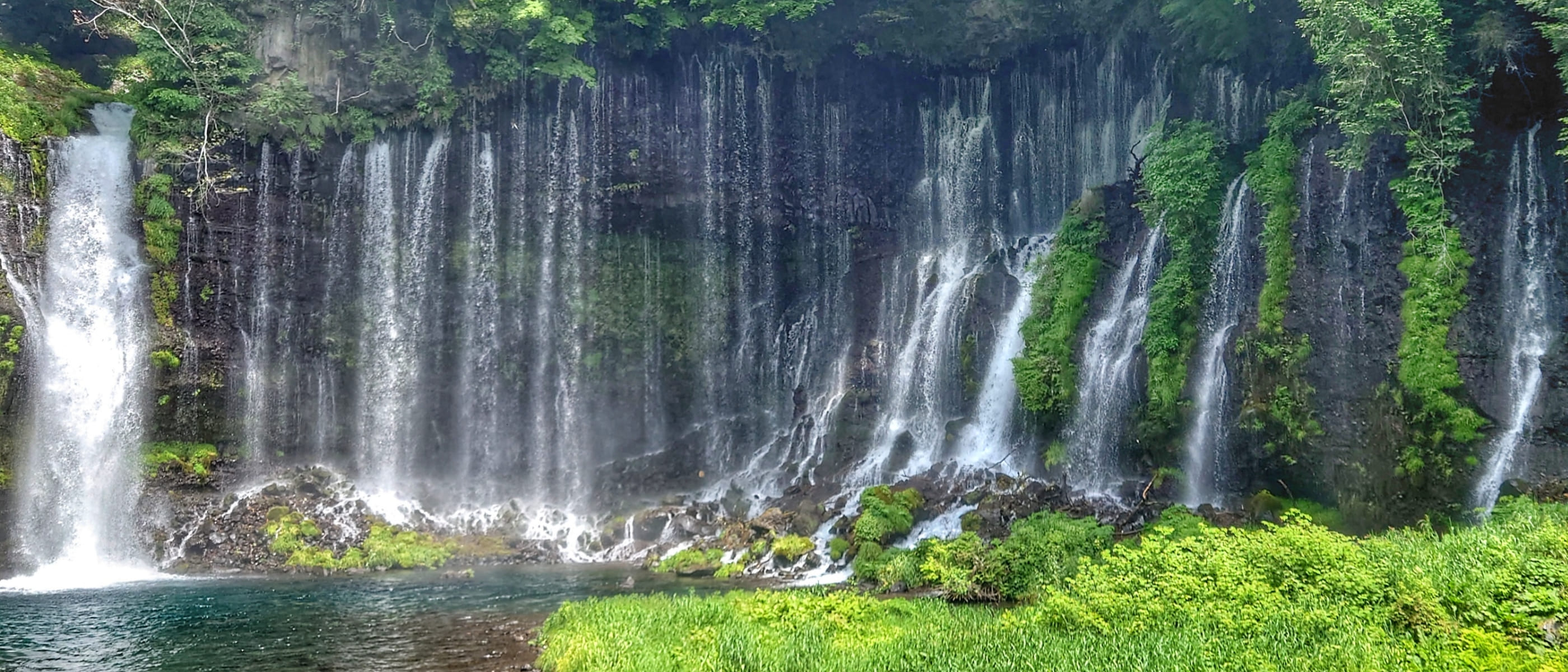
A waterfall where the meltwater from Mount Fuji springs from a cliff. The area around Shiraito Falls, including the falls themselves, has been designated as a Place of Scenic Beauty and a Natural Monument by the country.

A trail starting from Fujisan Hongu Sengen Taisha, passing through Murayama Sengen Shrine, and leading to the summit of Mount Fuji. The areas above the sixth station are part of the World Heritage Site components of Mount Fuji.
*Please use your browser’s translation function as this site is in Japanese.

Available from the taxi stand at the north exit of JR Fujinomiya Station.

*When using the Tokaido Shinkansen, Tokaido Line, or Minobu Line. The time will vary depending on the schedule.

The Sengen Shrine at the foot of Mount Fuji enshrines Mount Fuji as a deity (known as Sengen no Okami or Sengen Great Deity) to calm its eruptions. Fujisan Hongu Sengen Taisha (hereafter referred to as “Sengen Taisha”) is considered the earliest established shrine. Sengen Taisha is regarded as the head shrine of the many Sengen shrines across Japan. According to the “Fujisan Hongu Sengen Shaki,” it was relocated from the grounds of Yamamiya Sengen Shrine to its current location in the first year of the Daido era (806). Sengen Taisha is situated at the end of Mount Fuji’s lava flow, and within its precincts is the Wakutama Pond (a National Special Natural Monument), which is fed by groundwater emerging from the lava cave. Sengen Taisha was believed to be placed nearby Wakutama Pond due to the idea of calming eruptions with water.
As pilgrimages became more popular, it, along with Kobo-ji Temple in Murayama, became the starting point of the Omiya-Murayamaguchi pilgrimage route, leading to the establishment of lodgings for pilgrims in the surrounding area. The “Silk-Colored Fuji Mandala” depicts pilgrims cleansing themselves at Wakutama Pond before ascending Mount Fuji. In the early modern period, the shrine received the patronage of the shogunate, and the current shrine buildings were constructed in 1606 through donations from Tokugawa Ieyasu. The “Keidai Zusha” of 1670 shows the main shrine built in the Sengen-zukuri style, the tower gate, and other shrine buildings, as well as Wakutama Pond and Kagami Pond. In 1609, Sengen Taisha was granted the right to collect offerings at the summit of Mount Fuji, and in 1779, the shogunate officially recognized its control over the area above the eighth station. While the land above the eighth station became state-owned in the Meiji period, it was returned to Sengen Taisha in 2004 following a Supreme Court decision in 1974.

The main hall, or honden, features a two-story tower construction style known as “Sengen-zukuri.” The structure stands at a height of 45 shaku. (13.6 meters)
※Shaku is one of the units in the traditional East Asian system of weights and measures. 1 shaku is 30.3cm.
The lower level is built in the irimoya-zukuri style with dimensions of 5 ken by 4 ken, while the upper level is in the sankensha nagare-zukuri style. Both levels are roofed with cypress bark shingles. On May 27, 1907, it was designated as a specially protected structure under the Ancient Shrines and Temples Preservation Law, and has since been given special protection as a nationally designated Important Cultural Property.
※Ken is also one of the units in the traditional East Asian system of weights and measures. 1 ken is about 1.82m

Worship Hall (Haiden):
The hall is 5 ken by 3 ken in size.The front is built in the irimoya-zukuri style, and the rear in the kirizuma-zukuri style. The roof is made of cypress bark shingles. A one-ken-wide portico is attached to the front.
A veranda runs around three sides of the hall, and the rear connects to the offering hall.
Offering Hall (Heiden):
This hall connects the main hall (honden) and the worship hall (haiden). It is 3 ken by 3 ken in size.
The roof is in the ryokoshira-zukuri style, also made of cypress bark shingles.
The northern side reveals the edge of the main hall’s roof.
Perforated Fence (Sukibei):
There are two structures: One surrounds the main hall. The other encloses a larger area that includes the Sannomiya and Shichinomiya shrines beside the main hall. The total length is 36 ken.

The tower gate is a three-ken by one-door, two-story Irimoya-zukuri style structure with a cypress bark shingle roof. Doors are on the front and both sides. Guardian statues (Zuishin-Zou) are enshrined on the left and right sides of the gate.

Wakutama Pond is formed by rain and snow from Mount Fuji that turns into groundwater, flows through the lava layers of the Fujinomiya lava flow, and emerges at the end of the flow to create the pond. The pond is divided into an upper and lower pond near the Misogi area. Previously, only the upper pond was called Wakutama Pond, while the lower pond and downstream were known as Mitarashi River. This pond is closely related to Mount Fuji worship, where climbers (pilgrims) purified themselves with its water before ascending the mountain.
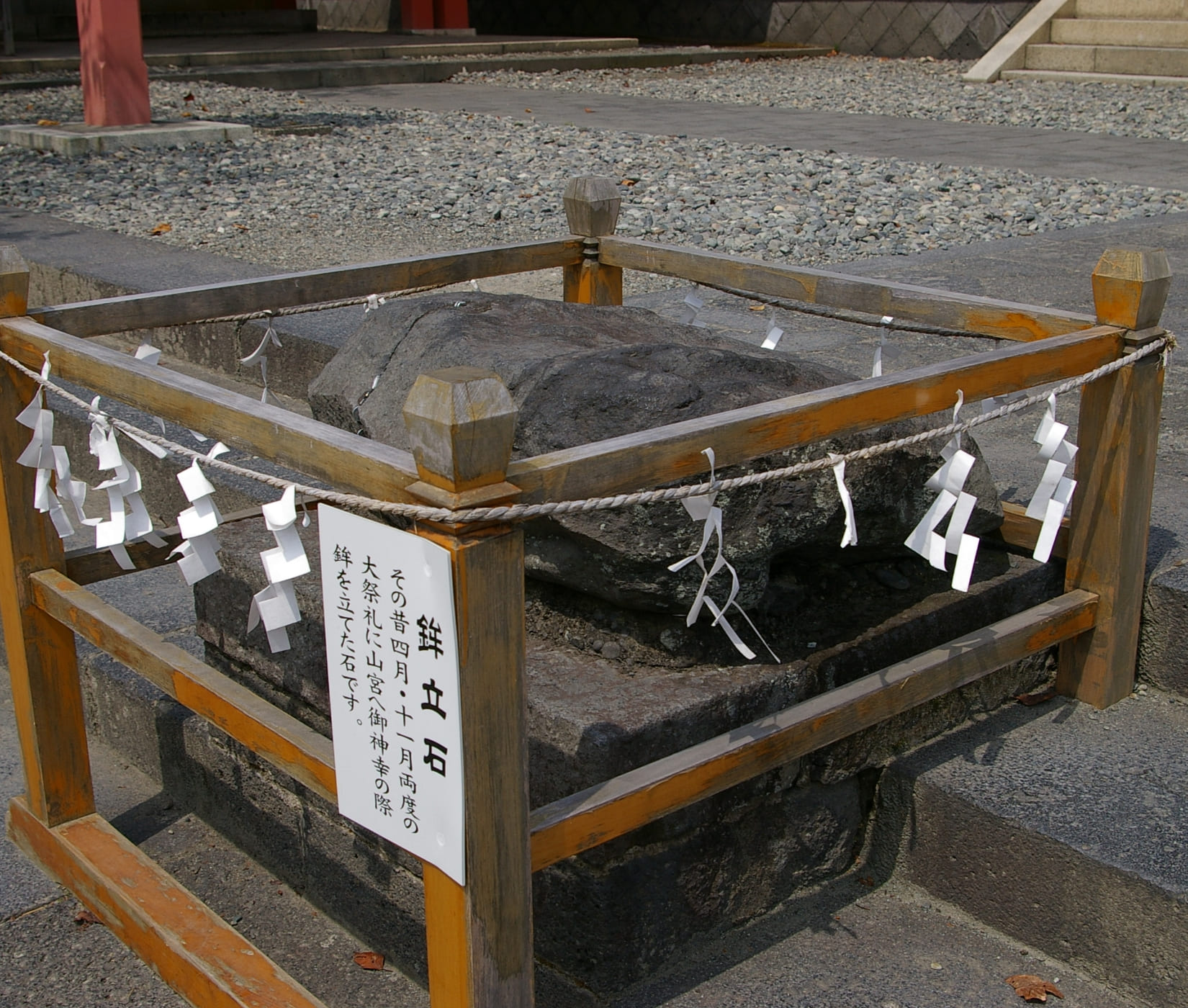
The Hokotate Stone is located on the stone steps in front of the tower gate. This natural stone was used during the “Yamamiya Goshinkō” ceremonies, conducted until the early Meiji period, to rest the sacred spear imbued with the spirit of the deity.
Address: 1-1 Miya-cho, Fujinomiya City, Shizuoka 418-0067
Fujisan Hongu Sengen Taisha: +81-544-27-2002
Open all year round
Admission: Free
Opening Hours:
November to February: 6:00 AM to 7:00 PM
March and October: 5:30 AM to 7:30 PM
April to September: 5:00 AM to 8:00 PM

Yamamiya Sengen Shrine features a remote worship site specifically for venerating Mount Fuji from afar, which is considered a retention of ancient Mount Fuji worship practices. The site is located at the end of a lava flow, surrounded by a stone rampart made of lava cobbles. The arrangement of stones within the site is oriented towards Mount Fuji, aligning with the mountain’s axis.
According to the “Fujisan Hongu Sengen Shaki,” Sengen Taisha was relocated from the land of Yamamiya Sengen Shrine. The exact date of the establishment of Yamamiya Sengen Shrine is unknown; however, archaeological excavations have unearthed 12th-century pottery (kawarake) presumed used in ceremonies, and historical documents confirm its existence from the 16th century.
Historically, the deity of Sengen Taisha would travel between Sengen Taisha and Yamamiya Sengen Shrine during the “Yamamiya Goshinkō,” a ritual procession held in spring and autumn. In 1691, during the Genroku era, markers were placed every 109 meters (one chō) along the 50-chō-long ceremonial path (Goshinkō road). After 1874, the Yamamiya Goshinkō was discontinued, and most of the markers have been lost, making the exact route now unclear.
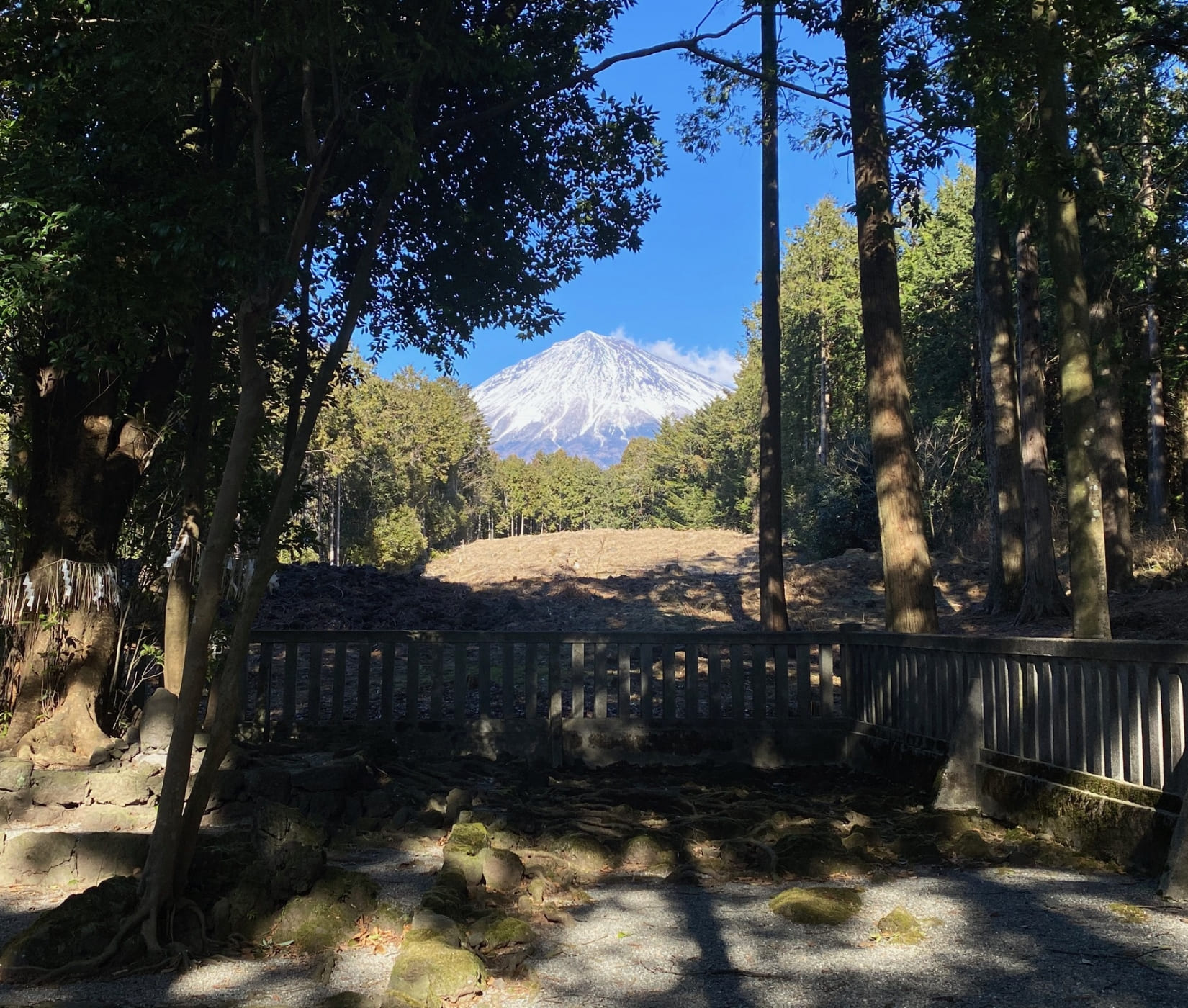
Yohaisho is believed to have been constructed to directly venerate Mount Fuji and conduct ceremonies. It is a rectangular area measuring approximately 15 meters north to south and 8 meters east to west. The site is structured with rows of lava stones, each about 30-40 cm in size.
The altar, positioned to face Mount Fuji, is flanked on the left by seats designated for the chief priest, the shrine’s officials, and the offering place during rituals. On the right side, seats are arranged for the bettō (temple stewards) and shrine monks.
Note: Currently, to protect this cultural asset, entry inside the tamagaki (fence) of the remote worship site is not permitted.

Along the pathway to the remote worship site, after passing through the Kagoya (shrine office), there are stones specifically placed for resting the sacred spear imbued with the deity during the “Yamamiya Goshinkō” ceremonies. These stones are volcanic bombs and are strategically placed: one immediately after passing the Kagoya and another just before the stone steps. In total, there are two such stones positioned along the path.

The Komoriya at Yamamiya Sengen Shrine was where the chief priest and other shrine officials, including shrine monks, would stay overnight during ceremonies. The current Komoriya, which functions as the shrine office, was built in 1933. The specifics of the previous Komoriya are unknown, and it is possible that temporary structures were erected for ceremonies in the past.
Address: 740 Yamamiya, Fujinomiya City, Shizuoka 418-0111
Yamamiya Sengen Shrine Information Office: +81-544-58-5190 (Open only on weekends and holidays)
Open all year round
Admission: Free
Information Office Hours:
The Yamamiya Sengen Shrine Information Office is open from 10:00 AM to 3:00 PM on Saturdays, Sundays, and public holidays.
During open hours, visitors can receive guided tours from Mount Fuji World Heritage guides
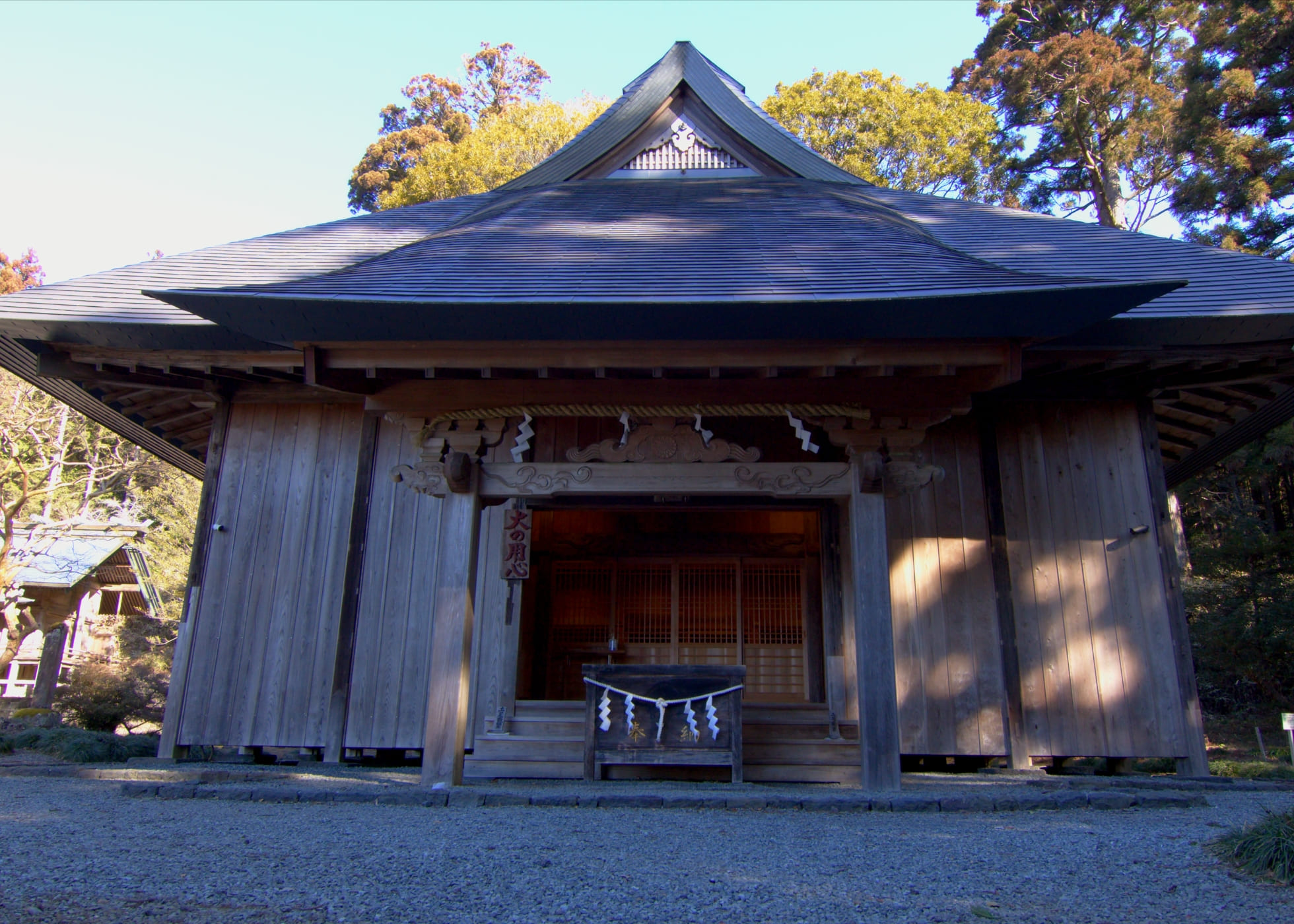
Shugendo is a uniquely Japanese syncretic religion that aims to obtain various “signs” by secluding oneself in the mountains and undergoing rigorous training.
Murayama was the central location for Shugendo (a Japanese mountain asceticism-shamanism incorporating Shinto and Buddhist concepts) practices on Mount Fuji, featuring the temple known as Shinko-ji until it was abolished during the anti-Buddhist movement of the Meiji Restoration. The establishment of the temple is thought to have occurred during the Kamakura period, linked to the practices of itinerant monks associated with Matsudai Shonin. Notably, Murayama is home to a statue of Dainichi Nyorai (Great Sun Buddha), inscribed with the year 1259.
In 1486, a significant visit by Monk Doei from Shogo-in Monzeki marked the temple’s alignment with the Honzan sect. By the early Sengoku period, Shinko-ji enjoyed the protection of the Imagawa clan, becoming a gathering place for ascetic monks and pilgrims, with many lodgings built in its vicinity. The “Silk-Colored Fuji Mandala,” dating from the 16th century, depicts pilgrims engaging in rituals and purifications at Shinko-ji. Murayama, located on a higher elevation than surrounding settlements, controlled access through east and west checkpoints during the Sengoku period.
In the Edo period, Murayama was managed by the “Murayama Sanbo” (three lodges of Murayama: Ikenishi-bo, Tsujinobo, and Omikamibo), who along with Shinko-ji, supervised the Omiya-Murayamaguchi pilgrimage route and the Dainichi-do at the summit. This era saw Murayama as a Shugendo village centered around Shinko-ji, inhabited by ascetic monks and temple farmers. During the climbing season, licensed guides from regions as far west as the Kinai region brought pilgrims to Murayama. During the Genroku era, the shogunate’s donations helped establish the current precincts of the temple.
The 1872 governmental edict to separate Shinto and Buddhism resulted in the secularization of the ascetic monks, the dissolution of Shinko-ji, and the separation of its main sanctuaries, the Sengen Shrine and Dainichi-do. Additionally, the Dai-Touryou Gongensha shrine was abolished and relocated to be revered as the general protector deity of Takamine. Although the Shugendo practice was officially banned in 1872, the activities of Murayama’s Houen (ascetic monks) continued until the 1940s.
By 1906, the development of new climbing routes caused these historical sites to fall out of the main pilgrimage paths, further diminishing their use.

The Sengen Shrine at Murayama was constructed with the sanctuaries of the Fuji Sengen Seven Shrines as subsidiary shrines following the governmental decree to separate Shinto and Buddhism. The main deities enshrined are as follows: Konohana Sakuya-hime in the central seat; on the left, Oyamatsumi-no-Mikoto, Hikohohodemi-no-Mikoto, and Ninigi-no-Mikoto; on the right, the divine figures of Oohirume-no-muchi (Amaterasu Omikami), Izanagi-no-Mikoto, and Izanami-no-Mikoto.
The current shrine building was reconstructed in 1913 during the Taisho era. However, due to aging, the offering hall and worship hall were later rebuilt using a combination of reinforced concrete and wood to address the deterioration.

The Dainichi-dō, the central building of Kōhōji Temple that existed until the early Meiji period, is considered to be a late Edo period construction due to the condition of its components and the distinctive characteristics of its Western-style carvings. It is the only existing building from the Edo period in this category.
Inside the building, wooden statues of Dainichi Nyorai (Great Sun Buddha) and En no Gyōja (the founder of Shugendō) are enshrined. The columns still bear pilgrimage stickers from the Fuji ascetic practices, strongly conveying the remnants of past Shugendō beliefs.
Note: In August 2013, the name was changed from “Dainichi-dō” to “Fujisan Kōhōji Dainichi-dō”.

The Misogi site is where mountain ascetic monks (Yamabushi) and pilgrims (Dōja or Dōsha) performing the practice of Shugendō, as well as those climbing Mount Fuji, would undergo a purification ritual called misogi to cleanse themselves. The site is located midway within the shrine grounds and is a rectangular area approximately 6.5 meters wide by 4 meters deep, with a depth of about 0.6 meters. The bottom is lined with stones, and the perimeter is constructed of stone masonry. An image of Fudō Myō-ō, considered the principal deity during Yamabushi training, is placed at the water outlet.
The water source for the Misogi site is believed, based on old maps and archaeological findings, to have been channeled from the “Dragon Head Pond.”

Located on the east side of the Dainichi-dō, the Goma altar has a stone statue of Fudō Myō-ō enshrined at the back. The altar is enclosed within a square stone structure, each side measuring 5.3 meters, and contains a circular stone arrangement for performing Goma rituals (fire rituals). In front of the Goma altar, there is a stone inscribed with the era name “September Fourth year of Ansei” (1857) and the names of the creators, suggesting that it was established by the yamabushi of Murayama Shita, such as those from Ryūhō-in.
Historical maps indicate that this area might have been where the worship hall of the Dai-Touryou Gongensha shrine once stood.
Address: 1151 Murayama, Fujinomiya City, Shizuoka 418-0012
Murayama Sengen Shrine Information Office: +81-544-26-6713 (Open only on weekends and holidays)
Open all year round
Admission: Free
Information Office Hours:
The Murayama Sengen Shrine Information Office is open from 10:00 AM to 3:00 PM on Saturdays, Sundays, and public holidays.
During open hours, visitors can receive guided tours from Mount Fuji World Heritage guides.
Note: The office is closed during the New Year holidays (December 29 to January 3).

Located within the precincts of Hitoana Sengen Shrine, the Hitoana Fuji-kō relics include a 83-meter long lava cave named “Hitoana” formed within the Inusuzumi-Yama lava flow, and over 200 monuments and monuments erected by members of the Fuji-kō, a religious pilgrimage group. Additionally, the Kōunai Road (Hitō Road), which connected to the Koshu Kaido and the Gunma region of Yamanashi Prefecture, once passed through this area.
According to the historical chronicle “Azuma Kagami,” the exploration of Hitō is documented, and stories from these explorations were later compiled into a narrative known as “Hitō Sōshi,” highlighting the miraculous powers of Asama Daibosatsu. This became widely popular in the Edo period with the prosperity of Fuji-kō.
Historical records of Fuji-kō mention that Hasegawa Kakugyō, the founder of Edo’s Fuji-kō, meditated in Hitō and received revelations from Sengen Dainichi Nyorai. Kakugyō’s teachings spread around Edo during the mid-Edo period, leading to the formation of numerous Fuji-kō groups. Kakugyō is said to have died in Hitō, which was revered as the Pure Land (Jōdo-mon) of Fuji-kō. As such, Hitō became a site of veneration as Kakugyō’s place of ascetic practice and passing, as well as the abode of Sengen Dainichi Nyorai. Many followers visited for pilgrimage and ascetic practices, and it was common to erect monuments and memorial stones for past leaders there.
In the early modern period, Hitō housed Kōkyū-ji (Dainichi-dō), believed to have been a facility caring for ascetic monks, managed by the Aka-ike family. The Aka-ike family also managed the “Hitō” cave and its surroundings, guiding pilgrims, caring for ascetic monks, distributing talismans and seals, and overseeing the erection of monuments.
Following the Meiji government’s separation of Shinto and Buddhism and the anti-Buddhist movements, Kōkyū-ji (Dainichi-dō) was abolished, and Hitoana Sengen Shrine was established. In 1942, the area was requisitioned for military use, leading to the relocation of Hitoana Sengen Shrine and local residents. The shrine was restored to its current location in 1954. The tradition of erecting monuments ceased after 1964 due to the decline of Fuji-kō activities.

Inside the Hitoana Cave, there are three monuments, four stone Buddhas, and a shrine established within. The cave’s entrance is located at the southwest end, and it bends into a hook shape around the central part. About 20 meters from the entrance, there is a shrine, and just before the 30-meter bend in the center, there stands a lava column approximately 5 meters in diameter. The cave extends to about 80 meters in depth and is believed to be closed off at the far end.
Note: Access to the cave is possible only in certain sections that have been made safe. (Entering the cave requires prior registration.) Please do not enter without permission due to cultural preservation and safety concerns.
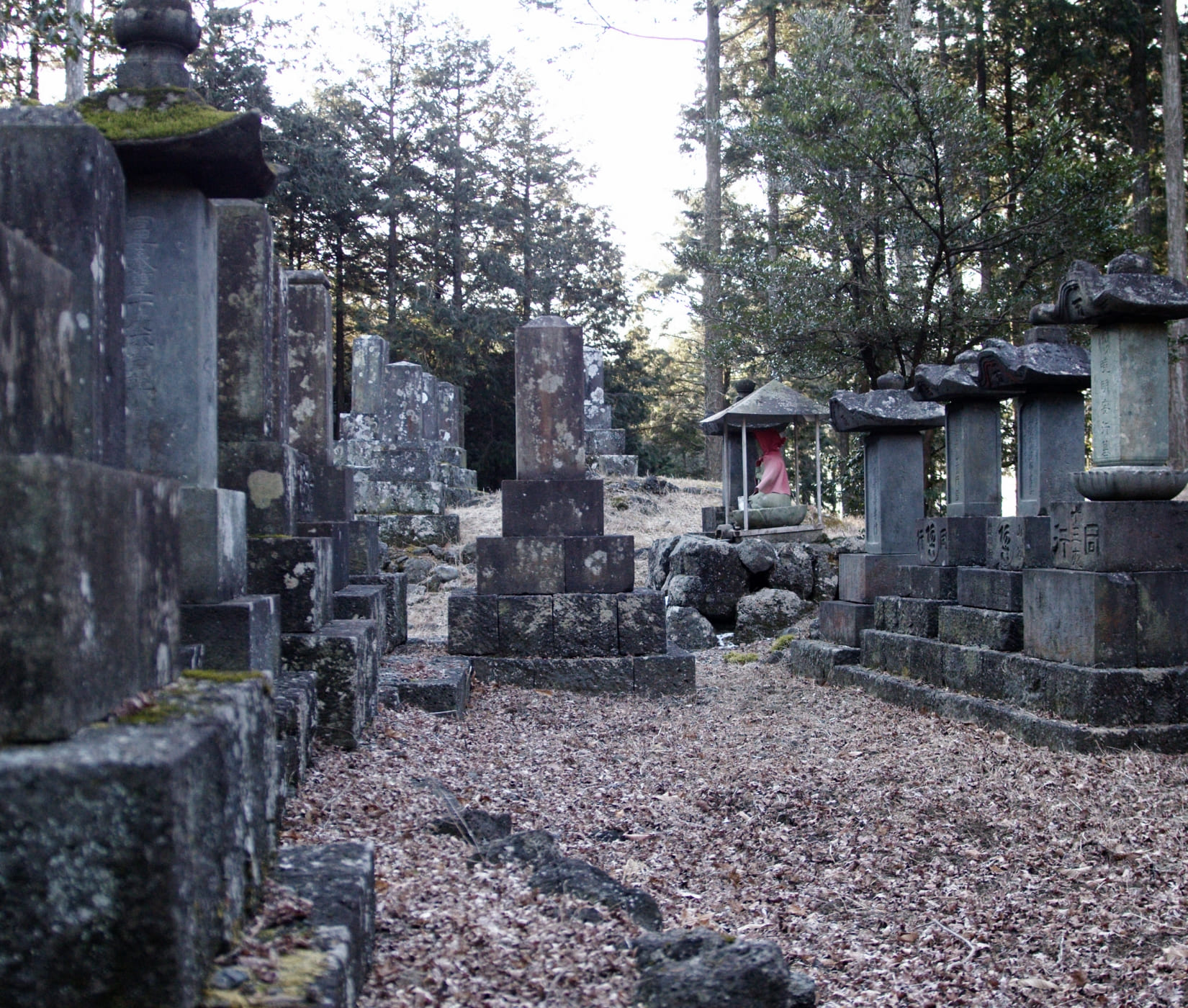
Within the grounds of Hitoana Sengen Shrine, there are 232 monuments erected by followers of the Fuji-kō. As the Fuji-kō flourished around Edo (modern Tokyo) from the mid-18th century, Hitō became revered as a sacred site (known as the “Western Pure Land”). Since the late 18th century, followers of the Fuji-kō, primarily from the Kanto region including Tokyo, Saitama, and Chiba prefectures, have established various types of monuments such as “grave memorial monument,” “prayer offering monument,” and “honorary commemorative monument.” These were typically erected by branches of the Fuji-kō, grouped together, allowing the history and regional composition of each branch to be discerned from the inscriptions.
Note: Some sections with maintained paths are available for viewing. Please do not cross the barriers without permission due to cultural preservation concerns.

Previously, the site was home to Kōkyū-ji Dainichi-dō, a Buddhist temple structure. However, following the Meiji government’s directive to separate Shinto and Buddhism, the temple was dismantled, and Hitoana Sengen Shrine was established in its place.
With the opening of the Juvenile Tank Troops School in 1942, the area became a military training ground, necessitating the relocation of Asama Shrine. The shrine was restored in 1954, and the current shrine building was constructed in 2001.
Address: 206 Hitōana, Fujinomiya City, Shizuoka 418-0102
Hitōana Fuji-kō Relics Information Office: +81-544-52-1620 (Open only on weekends and holidays)
Open all year round
Admission: Free
Information Office Hours:
The Hitōana Fuji-kō Relics Information Office is open from 10:00 AM to 3:00 PM on Saturdays, Sundays, and public holidays.
During open hours, visitors can receive guided tours from Mount Fuji World Heritage guides.
Note: The office is closed during the New Year holidays (December 29 to January 3).

The site known as “Shiraito no Taki” has been designated as a place of scenic beauty and natural monument by the national government since 1936. This designation includes both “Shiraito Falls” and “Otodome Falls”. Additionally, from the late Sengoku period to the early Edo period, it is said to be the site where Hasegawa Kakugyo, the founder of the Fujiko faith, conducted his ascetic practices, making it a place of pilgrimage and training for people centered around the Fujiko faith.

Shiraito Falls is formed by rainwater that falls at the foot of Mount Fuji and emerges from the boundary between the upper permeable layer (Shin-Fuji volcanic strata) and the lower impermeable layer (Ko-Fuji volcanic strata). The water maintains a constant temperature of 12°C throughout the year, and it is said that 1.5 tons of water flows every second. The waterfall itself is approximately 20 meters high and spans over 150 meters in width. From a curved cliff, hundreds of small and large waterfalls cascade down like white threads, creating a stunning visual display.
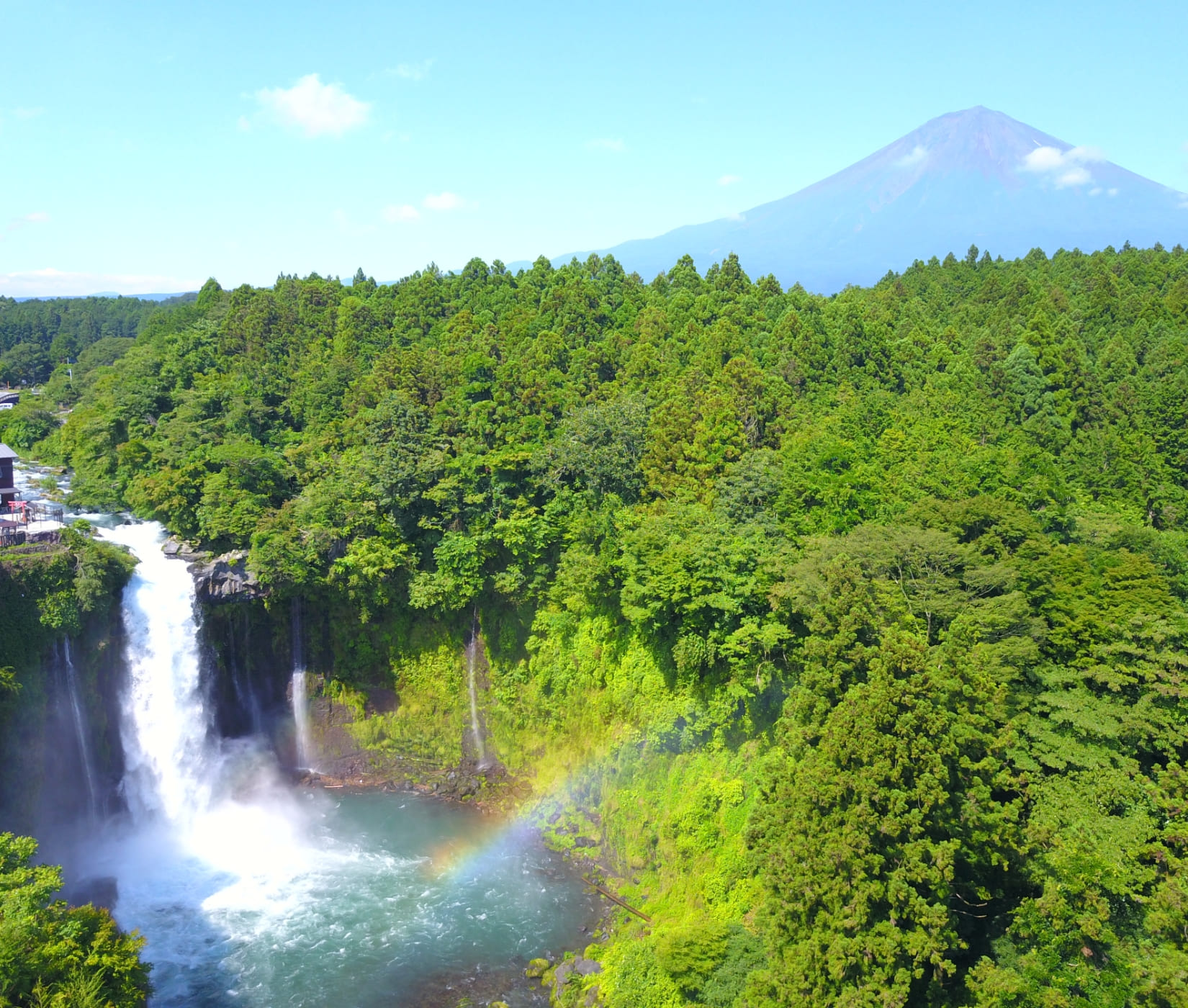
Otodome Falls is located on the eastern side of the plateau, separated from Shiraito Falls. The main part of the falls is the main stream of Shibakawa River, which cascades down a drop of about 25 meters, resonating with a thunderous roar. Similar to Shiraito Falls, the cliff face at Otoshi Falls exhibits the same strata, where spring water can also be observed.
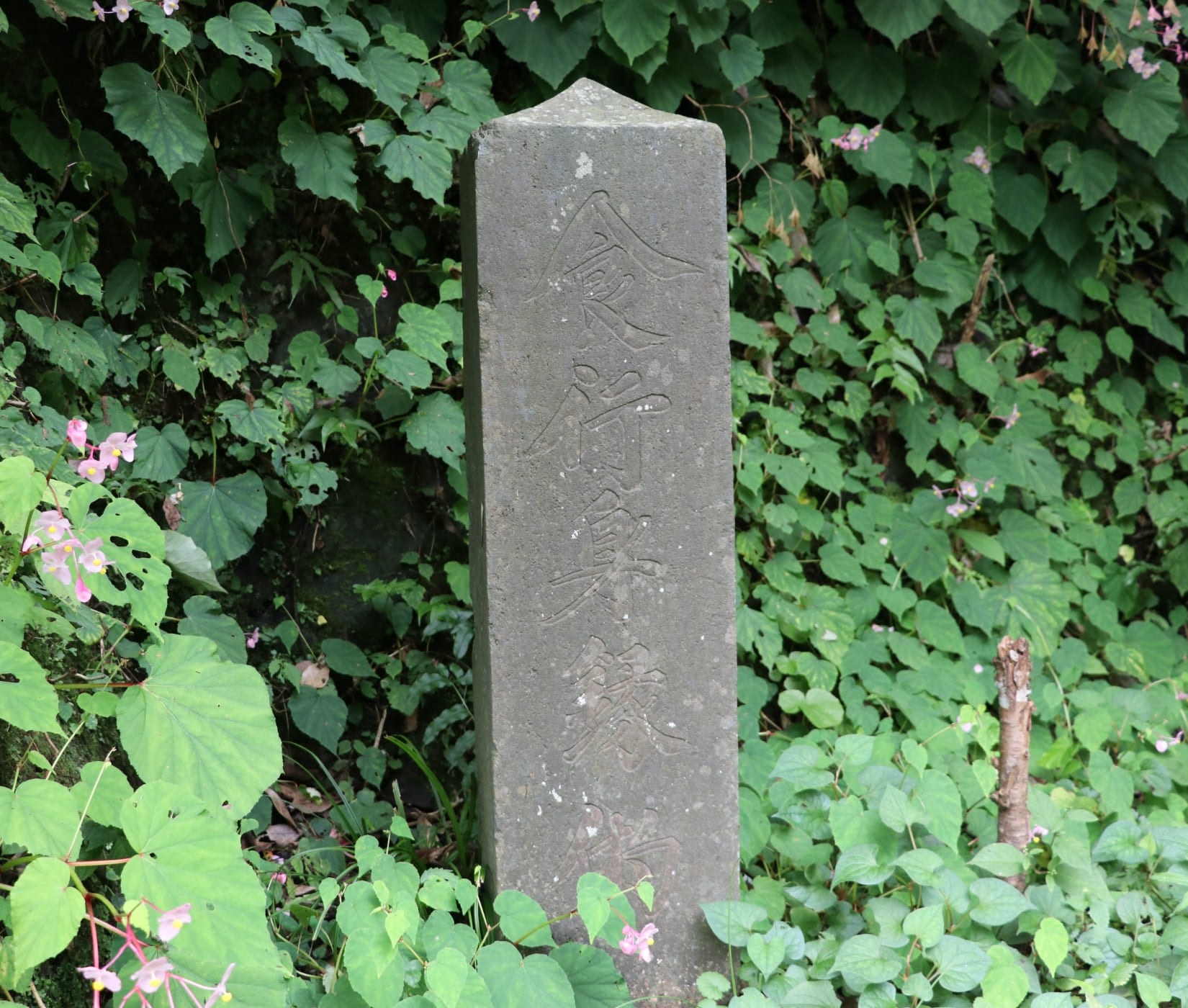
Within the designated area, stone monuments remain erected by followers of the Fujiko faith. The monument, known as the “Jikigyou Miroku” stele, is said to have been constructed in the third year of the Tenpou era (1832) to commemorate the 100th anniversary of the Jikigyou Miroku memorial service.

Obinmizu is a spring-fed pond located atop the cliff of Shiraito Falls. The water is exceptionally clear, reflecting the surrounding scenery like a mirror. The origin of its name is said to come from an incident involving Minamoto no Yoritomo, a famous historical figure. During a hunting expedition on Mount Fuji, Yoritomo used the water’s reflective surface to fix the disarray in his hair, specifically his sideburns, which is how the pond got its name “Obinmizu,” meaning “sideburn water.”
Address:Fujinomiya City, Kamiide, 418-0103
Contact (Weekdays only): Fujinomiya City Hall (Main line): 0544-22-1111Transportation:
About 30 minutes by car from JR Minobu Line Fujinomiya Station.
Approximately 40 minutes by car from Tomei Fuji Interchange.
From Fujinomiya Station on the JR Minobu Line, take the bus from Bus Stop No. 2 (Shiraito Line), and get off at Shiraito Falls Bus Stop [about 24 minutes, fare: 600 yen].
The Shiraito Falls is closed to swimming. Entry into the plunge pool is prohibited.

During the late Heian period, climbing Mount Fuji became a common practice, and by the early 14th century, it is believed that ascetic monks began gathering at Murayama as their base for conducting training on the mountain. In the medieval period, led by experienced ascetic monks known as “Sendatsu,” many pilgrims started to climb the mountain regularly. A 16th-century painted silk mandala, “Kenpon Chakushoku Fujimandara-zu,” depicts pilgrims ascending Mount Fuji from the Omiya and Murayama routes.
In the early modern period, the “Murayama Sanbou” (Ikenishi Bou, Tsuji no Bou, and Okagami Bou) managed the climbing routes. Along these paths, facilities such as mountain lodges, “Fudauchi-ba” (checkpoint), “Chugu Hachimando,” and “Omuro Dainichi-do” were established. Chugu Hachimando, also known as “Umagaeshi,” was the point up to which horses could be used; beyond this point, pilgrims had to proceed on foot, and it was a common place to purchase a “kongo-tsue” (a type of walking stick). According to records from Okagami Bou in the late 18th to early 19th century, the number of pilgrims using the Omiya-Murayama route was around 2,000 during special pilgrimage years and a few hundred in typical years.
In 1906 (Meiji 39), a new route was constructed that bypassed Murayama, leading directly from Omiya to the sixth station (Omiya-Murayama route, fourth station: elevation approximately 2,600 meters). The sections below the sixth station lost their function as pilgrimage routes. As a result, apart from some sections, it is difficult to trace the old pilgrimage routes. The World Heritage designation includes the area from the sixth station upwards.

The Omiya-Murayama route is a trail that passes through Omiya and Murayama, reaching the southern side of the summit. The designated area is currently still in use as the Fujinomiya route for climbing starts from the sixth station upward (on Prefectural Road 180). Along the trail, there are seven mountain lodges in operation.
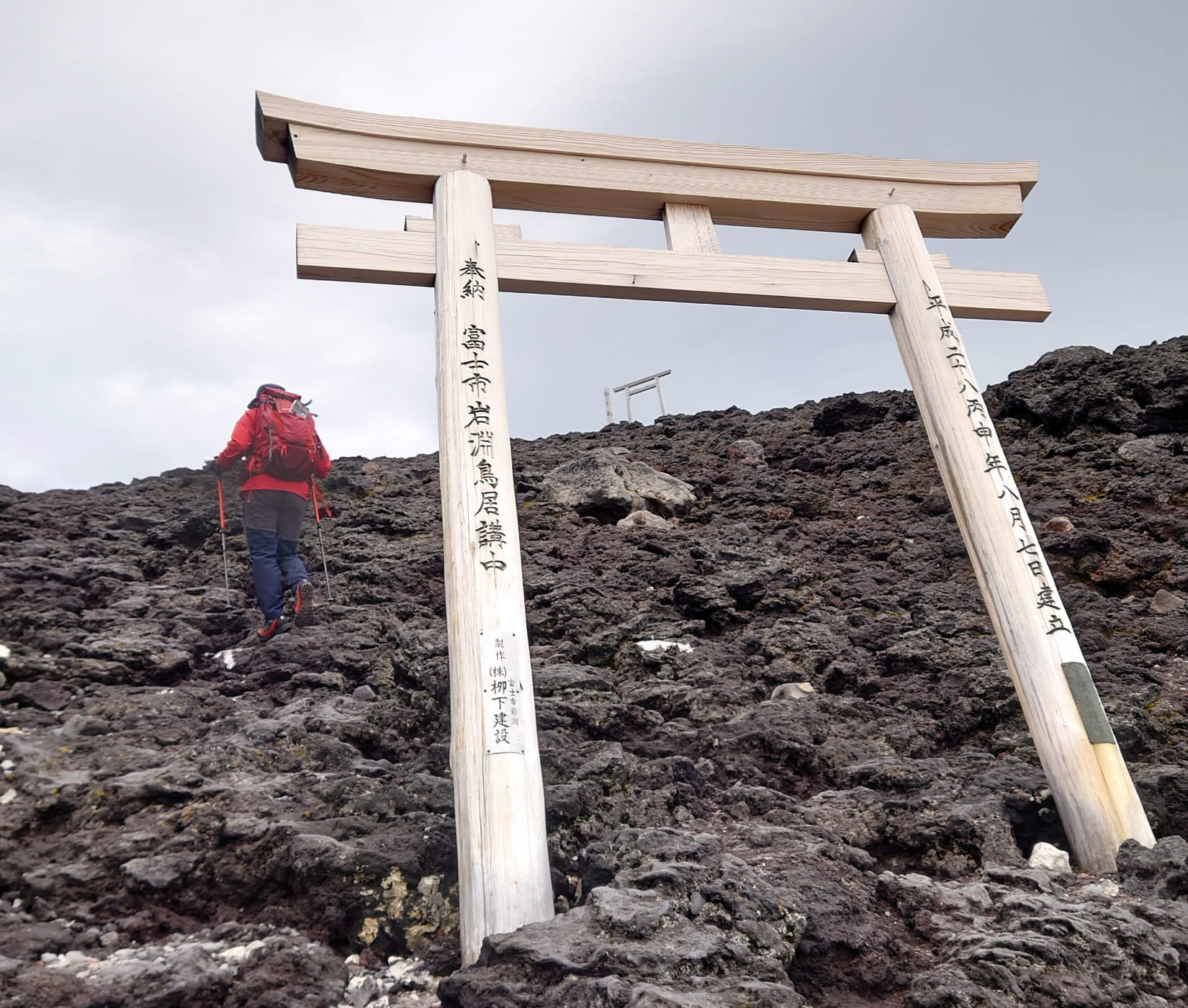
As you ascend the Fujinomiya trail towards the summit of Mount Fuji, you will come across a wooden torii gate located just before the peak. The legs of the torii are inscribed with the following: “Established on July 24, Heisei 16 (2004), Dedicated by the Iwabuchi Torii Kō of Fujikawacho.”
In the Iwabuchi area of Fujikawacho, there is a longstanding tradition known as the Torii Kō. This event involves a group making a pilgrimage to the summit of Mount Fuji once every twelve years during the Year of the Monkey to dedicate a torii gate. This ritual symbolizes a deep spiritual connection to the mountain, celebrated through this communal act of faith and dedication.

Fudauchi-ba is a special place where ascetic monks affix prayer plaques embedded with their wishes. The site features a Zelkova tree with a trunk circumference of 3.5 meters, around which a rope is wrapped. Monks tie their prayer plaques to this rope. Even today, monks continue to visit this site to attach their plaques, maintaining a tradition of expressing hopes and prayers in this sacred and venerable setting.

Mount Fuji has long been a symbol of faith. However, there was a time when women were forbidden from making pilgrimages to the summit. At an elevation of 1260 meters, there are the remains of Chūgū Hachimandō and the nearby site known as Nyonindō, which have been artificially leveled, indicating the presence of buildings in the past.
Chūgū Hachimandō, also known as Chugu Umagaeshi, was a point up to which it was possible to travel by horse. Beyond this point, at a place called “Kennoji,” was the furthest point that women could reach on the traditional pilgrim route. It is speculated that women worshiped the summit of Mount Fuji directly from this location. This setup illustrates the constraints on women’s religious practices and their dedication to worship despite these limitations.

Mount Fuji was worshiped as a syncretic Shinto-Buddhist. However, with the Meiji era came significant changes in the form of religious worship. The impact of the Haibutsu Kishaku movement, which sought to abolish Buddhism, extended even to the Buddhist statues enshrined throughout Mount Fuji. Since there are no rivers on Mount Fuji, ascetic monks used bamboo leaves instead of water to perform ritual purification, known as “goma.” Traces of the Haibutsu Kishaku movement can be seen at the Sasagori site, where Buddhist statues, including images of Fudō Myō-ō, had their heads cut off.
This site is located at an elevation of 1860 meters along the climbing route from Murayama to the summit of Mount Fuji. The movement to distinguish and separate Shinto from Buddhism, promoted by the Meiji government, was thoroughly implemented even in such remote and difficult-to-access areas. As a result of this movement, the number of people passing through Murayama to the summit of Mount Fuji decreased. Today, it remains a lesser-known trail known only to those familiar with its history.
Fujinomiya City Hall, Planning Division, Mount Fuji World Heritage Section, Planning Department
Address: 150 Yumizawacho, Fujinomiya-shi, Shizuoka Prefecture 418-8601, Japan (3rd floor, City Hall)
Phone Number: 0544-22-1489
Fax: 0544-22-1206
Email: sekai@city.fujinomiya.lg.jp



